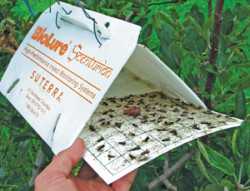Like Pavlov’s Dogs

As spring begins, apple growers from New York to South Carolina begin to scout for pests. Among those pests is the dogwood borer, a pest that originally attacked ornamental trees but has become increasingly damaging to apple trees. A heavy infestation can girdle the base of the tree trunk, causing death in the worst circumstances.
Over the last several years, a collaborative team of researchers from Virginia Polytechnic Institute and State University, USDA, and North Carolina State University (NCSU) have been delving into the chemical ecology of the male dogwood borer and examining the egg-laying preferences of the female dogwood borer. Their experiments have led them to discoveries that may eventually lead to the control of both males and females: a sex pheromone to lure males away from possible mates, and an attractant that could potentially be used to trap females.
In the 1990s, Virginia Tech plant pathologist Keith Yoder observed that dogwood borer damage at the base of apple trees was commonly misdiagnosed as a disease. When Virginia Tech entomologist Chris Bergh learned about Yoder’s findings, he decided to explore the issue. In collaboration with USDA researchers Tracy Leskey and Aijun Zhang, and NCSU entomologist James Walgenbach, Bergh began his research with one main question: Why were commercial pheromone lures for dogwood borer not consistently effective at attracting the pest to traps?
“We compared several commercial lures, and found that although one particular lure was more effective than the others, it still didn’t appear to accurately reflect the population size,” Bergh said.
The project goal was to create a pheromone that, when used as a lure in traps, could be used to accurately and reliably monitor the presence and abundance of male dogwood borer. In addition, since sex pheromones are presently used in control tactics designed to manage other pest species of moths, the team has investigated two such approaches for dogwood borer. One tactic, called mass trapping, seeks to remove large numbers of males from the population by capturing them in traps baited with pheromone lures. The other approach, called mating disruption, relies on deploying the pheromone in slow-release formulations within the crop, disrupting the ability of males to find females. The end result of both tactics is to reduce mating and the ability of females to lay fertilized eggs on the plant.
Luring Them In
The answer to Bergh’s research question lay in the chemical composition of the pheromone lure. After months of tests, Zhang discovered three pheromone components that, when combined in the proper ratio, attracted more dogwood borers than the most effective commercial pheromone lure, and even more than female dogwood borer moths: (Z,Z)-3,13-octadecadienyl acetate (ODDA); (E,Z)-2,13-ODDA; and (Z,E)-3,13-ODDA. After tests at several sites in Virginia, West Virginia, and North Carolina, the newly developed lures consistently caught significantly more male dogwood borers than any of the commercial products.
“We had higher trap captures than anyone had seen before,” said Bergh.
After recognizing that the commercial lures lacked the exact ingredients of the dogwood borer sex pheromone, the team discovered another problem: one of the chemicals produced a by-product during synthesis that actually repelled dogwood borers from the lure. This by-product was typically present in commercial lures, helping the team understand why current trap captures were lower than the team knew they should be. To create a fool-proof lure, they would have to find a way to synthesize the chemical without producing the contaminating by-product. Bergh’s team is currently experimenting with the chemical synthesis, a project partially funded by a Southern Region IPM grant.
Field trials conducted by researchers at Pennsylvania State University over three years showed that the three-component pheromone formulation reduced dogwood borer populations — and the resulting damage — over time. The success of the Virginia Tech/USDA/NCSU team’s discovery has led to interest in licensing the patent, which would put the new pheromone on the market.
Currently, the chemical Lorsban (chlorpyrifos, Dow AgroSciences) is the only effective control for dogwood borer, but it is due for EPA review in 2009. USDA and Virginia Tech have patented the pheromone blend, and the patent is currently available for commercial licensing. Ultimately, the hope is for the pheromone to be publicly available as an alternative management tool for dogwood borer. Manufacturer interest in formulating the improved pheromone lure for commercial production has made that a more promising possibility, although nothing definite has yet developed.
“In terms of the application of this, we are still in the research and development phase,” said Bergh. “But we are getting there at a rapid rate.”









